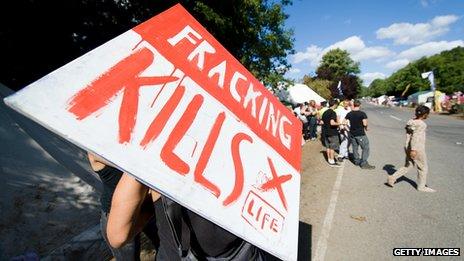Shale gas estimate in North West 'bigger' than previously thought
- Published

Map showing shale gas deposits, drilling licences and drill locations in the North West. Inset image: Area of the Fylde in Lancashire showing the Cuadrilla sites
Estimates of Cuadrilla's shale gas resource in the North West of England may have to be increased significantly upwards.
A geologist with the company said there is 330 trillion cubic feet (tcf) of gas in place in its licence area, 50% more than previous estimates.
Cuadrilla is the only company in the UK to have used hydraulic fracturing (fracking) in its test wells.
But it could take two years to see if the gas is commercially viable.
Last summer the British Geological Survey (BGS) reported that there could be around 1,300 tcf of gas in the Bowland basin in North West England.
Based on data from two wells that it had fracked in 2011, Cuadrilla estimated that there was around 200 tcf in its licence areas.
Now a more detailed analysis of seismic and well data suggests a significant upgrade to the gas potential of the area.
"In terms of the resource in place, we originally came out with 200 tcf," said Huw Clarke, a geologist with the company, told a conference in London, external.
"That was just off one well, that was ratified by the BGS, and we were very happy about that. Since then we've drilled two extra wells and we've shot 100sq km of 3D seismic information and I believe there's closer to 330 tcf in place just within Cuadrilla's licence area alone."
Cuadrilla's fracking at one of the locations, Preese Hall, was controversial as it was believed to have set off two small earthquakes in the area. This led to a temporary ban and new guidelines on safety and best practice, external.

Even though Cuadrilla didn't frack any wells in Sussex, their presence attracted huge protests
The company has become a target for environmental protestors who believe that fracking poses a threat to groundwater supplies.
However, the potential impact of shale gas on UK energy supplies and the economy has won the support of government and investors.
Last year, Cuadrilla sold a 25% stake in its Bowland exploration licence to Centrica, the company that owns British Gas.
Cuadrilla is now in the process of expanding its operation in Lancashire, announcing recently that it was seeking planning permission for two new sites at Roseacre Wood and Preston New Road.
It plans to drill and hydraulically fracture four exploration wells at each site.
"If you can get one of those eight wells to show that it is commercially viable, I think that would be a strong push to take it to the next stage which would be a field development plan," said Huw Clarke.
"But we're a couple of years off that."
Other speakers at the Shale UK conference were cautious about the potential boom in exploration, believing that recovering the gas would require extensive drilling.
Prof Andy Aplin, a former adviser to oil giant BP and now at Durham University, said that exploiting the Bowland shale, based on the example of the US, might require 33,000 wells.
"What we are looking at here is a massive increase in the number of wells if we are going to exploit this resource to the extent to which our political masters would like us to do, from the Treasury's point of view," he said.
The researchers underlined the fact that there was a significant lack of data about UK shale formations. There were many questions still outstanding, including the impact of fracking fluid on seismic faults.
"These reservoirs are really complicated, they are much larger and more complex on any spatial scale compared to our North Sea reservoirs - we should not pretend we know very much about the nature of the UK reservoirs today," said Prof Aplin.
The issue of the number of wells was also commented on by Lord Oxburgh, former chairman of Shell and a member of the House of Lords Select Committee on Science and Technology.
The experience in the US suggests that the output of shale gas or oil from fracked wells declines very quickly, increasing the need to drill new wells.
"The rate of flow drops by 85% over three years, a conventional well could still be getting high flow rates after 30 years," he said.
"There are other limiting factors in the UK, including the size and density of the population. And the process of fracking was extremely noisy.
"I think it is going to be a limiting factor near towns, these are brutes, these big pumping machines."
Follow Matt on Twitter @mattmcgrathbbc.
- Published24 February 2014
- Published4 February 2014
- Published4 February 2014